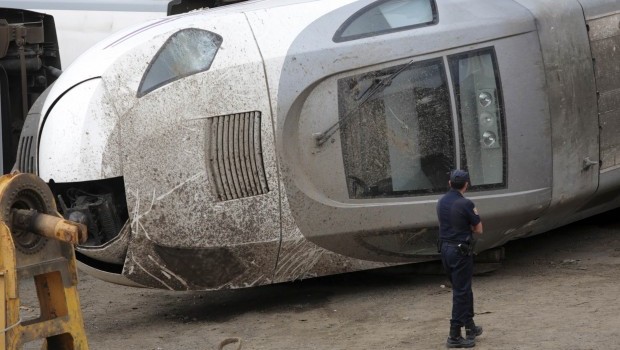
A Spanish National police officer stands next to wrecked parts of a train at a warehouse in Escravitude, 20 km (12 miles) from Santiago de Compostela, northwestern Spain, July 27, 2013. (Reuters/Miguel Vidal)
Santiago de Compostela, Reuters—The driver of a Spanish train that derailed at high speed killing 78 people was released from hospital on Saturday, but he remained in police custody ahead of an appearance before a judge to answer questions about what went wrong.
Francisco Garzon, 52, was treated for a head injury he sustained in Wednesday’s crash. He declined to give a statement to police on Friday.
“He … has been arrested by the police on charges of alleged reckless homicide,” Interior Minister Jorge Fernandez Diaz said at the police headquarters of Santiago de Compostela, the northwestern city where the crash occurred.
Police had already said Garzon, who has been under arrest since Thursday, was suspected of “recklessness” in driving the train much too fast through a curve on the outskirts of Santiago.
Survivors and families of victims from Spain’s deadliest train crash in decades were desperate for answers three days after the eight-carriage, high-speed train derailed on a sharp bend, slamming into a concrete wall.
Several bodies were still unidentified and dozens of injured were in hospital in serious condition.
“We have to investigate what happened, because there are lots of versions,” said Ricardo Jimenez, whose sister-in-law was killed in the crash and whose body was not identified until late on Friday.
“This can’t go unpunished, because those were people on the train, not animals, and other people shouldn’t have to pay because one person makes a mistake,” he told Reuters.
Officials are looking into whether the accident was the result of human error or a problem with the train, the track or the security system that controls speed on the railway.
Esther Dominguez, a 23-year-old student from Madrid who survived the accident, told Reuters: “I have really mixed feelings. On the one hand I feel fortunate to have come out of it okay, it’s a miracle, but I’m really sad about the people who didn’t come out as well and are suffering now.
“After something so huge you want to know why, what happened, so that it doesn’t happen again. They need to get to the bottom of it and find out who was responsible.”
The government has said a clearer picture would emerge from two official investigations, one judicial and one governmental, but there was growing pressure for assurances that Spain’s rail network was safe.
“It is essential that we get guarantees about what the public believed was a model railway system but which suddenly turns out to have worrying security flaws,” left-leaning newspaper El Pais said in an editorial.
Santiago was meant to be celebrating the yearly festival of St. James this week. Thousands of Christian pilgrims arrived after walking the famous Camino de Santiago trail over the Pyrenees, or from Portugal.
Festivities were canceled after the accident – which happened on the eve of St. James day. Although many were trying to return to normal life, the mood in the city was subdued.
“It’s as though people have lost their strength. It touches you deep inside,” said Ofelia Garcia, who arrived in Santiago on Monday with her partner after they walked the pilgrimage trail from Portugal.
Although each family will bury their dead separately, the region of Galicia – where Santiago is the capital – was preparing an official memorial for the victims on Monday.
Mourners placed candles at the entrance to the centuries-old cathedral and strung blue hydrangeas, picked from local gardens, through the bars of the gates.
Pilgrims left traditional walking sticks near the cathedral gates with hand-written notes in support of the victims and their families.
One read: “So that your journey does not end here.”
“We were about to open a bottle of wine when we started to hear sirens,” said 30-year-old American tourist Rebecca Elias.
“At first we thought it was fireworks for the festivities and then we found out about the accident, so we put the wine away and said a prayer.”
